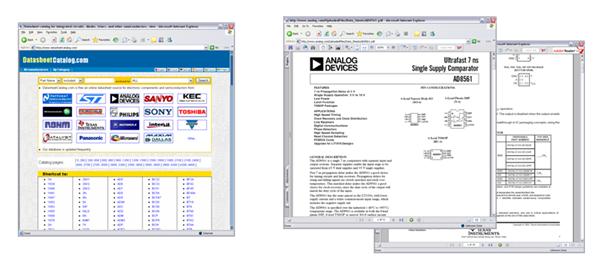Part Research and Selection
The most fundamental building part of a design is the physical component (such as resistors, operational amplifiers, transistors and digital components). Part research and selection requires the evaluation of components to investigate how each will work as a part of a design topology.
Information on device performance can be found at a number of online resources that housedatasheets. The datasheet contains information such as operating points, switching characteristics, design considerations etc…
Some web-sites where datasheets can be found include (but are not limited to):
Most component manufacturers also have datasheets available on their web-site.
Figure 3 - Example of datasheets
Many engineers like to gain a better understanding of how a component operates to complement the information on a datasheet. The first, time consuming method is to purchase the various components and physically breadboard a prototype to interrogate and analyze the device. This can require purchasing multiple devices and breadboarding at the most preliminary stages of the design process.
The second and more advantageous method begins to integrate the fragmented nature of the traditional PCB design flow. A capture and simulation environment can be used to select a device and simulate its overall behavior. Performance can be evaluated without needing to purchase and physically breadboard.
For example, in NI Multisim parts can be selected from a database of components, each of which has a simulation model associated with it to visualize operation. In the capture and simulation environment a design can be quickly built and simulated to view the overall operation of a device. The fact that no breadboards are required means a shortened component selection process.




No comments:
Post a Comment
Note: Only a member of this blog may post a comment.